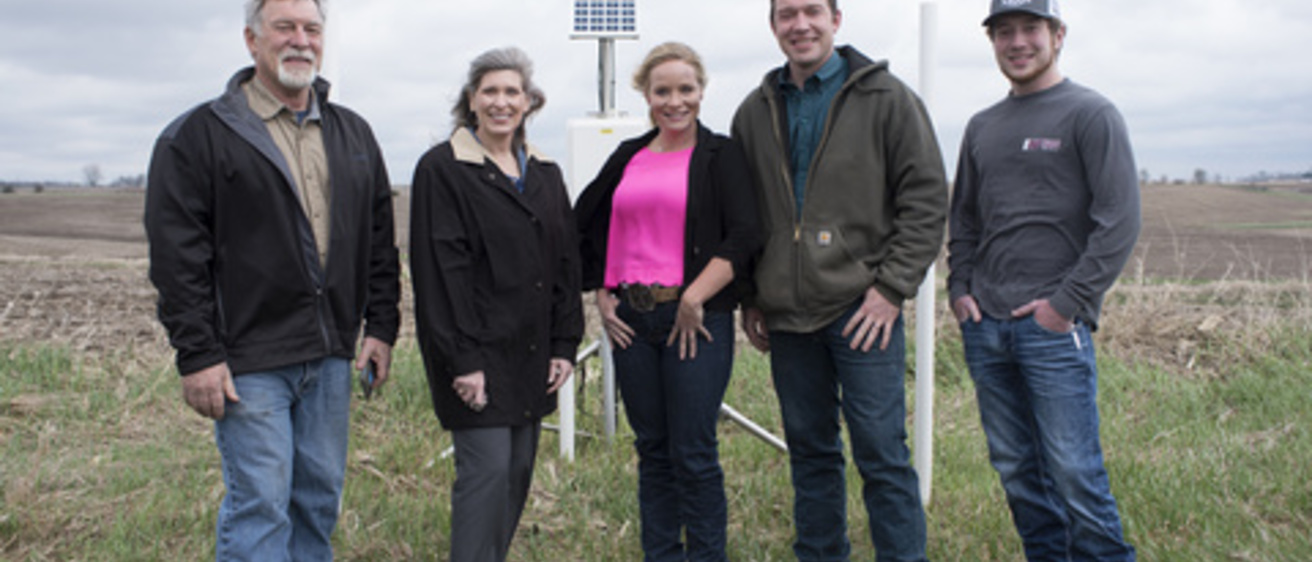Iowans love to talk about the weather, and there was plenty of weather to talk about when U.S. Senator Joni Ernst visited the Maas Family farm near Williamsburg recently. Despite strong winds and a chance of rain, Ernst came to learn more about the Iowa Watershed Approach (IWA). This was Senator Ernst’s Iowa County stop —#44 on her 99 County Tour for 2021. IWA is a five-year, $96.9M project designed to make Iowa more flood-resilient by working with volunteer landowners within watershed communities, building conservation practices to help restore the landscape’s natural resilience to floods.
Ernst and about 30 others — representing local government, watershed management authorities, landowners, the Iowa Flood Center (IFC), and more — gathered in the Maas shop before heading out to see the IWA hydrostation installed on the property.
IWA Clear Creek Watershed Project Coordinator John Rathbun welcomed the crowd to the Maas farm. By the end of the IWA project next year, Rathbun expects to see 70 completed conservation practices (such as farm ponds, wetlands, and more) in the Clear Creek watershed. Once installed, the practices will slow down the flow of stormwater through the basin, temporarily holding back 61-acre feet of runoff and reducing downstream flooding. This is equivalent to about 61 football fields at the depth of one foot of water.
Iowa County Supervisor John Gahring chairs the Clear Creek Watershed Coalition. “It’s been a phenomenal project,” he said, one that brought $2M to Iowa County. He spoke warmly of the IFC staff who have shared their expertise and data with local groups. “I can’t tell you the impact on our community,” he said.
IWA Project Lead Larry Weber, co-founder of the Iowa Flood Center, spoke about his vision for a rural/urban watershed project that would bring people together within a watershed to build community and improve flood resiliency.
“This is what good looks like,” Weber said, as he gestured to the diverse group around him. IWA has defined such efforts for the nation, he said, attracting groups from other states to Iowa to learn about the project and to study how they might emulate it in their own states.
But the work here in Iowa isn’t done, Weber noted – Iowa would benefit from another similar project. Weber said that landowner interest in the program far outstrips the resources available through IWA. “There’s an opportunity there to work with those landowners,” Weber said. “We need to figure out how to carry this thing forward.”
Farmer and landowner Jared Maas shared his desire to preserve and maintain his farm for future generations. “We want to keep our ground here,” he said. “Not send it down the river.”
Ernst praised the IWA and the “big benefits” it has brought to Iowa, including flood mitigation, nutrient management, improved soil health, enhanced ecosystems, habitat for wildlife, and more. And, she added, it’s not just Iowa that can benefit from such efforts — it could also help meet a nationwide need.
This is important work, Ernst concluded. How do we collaborate and make sure that these efforts are continually moving forward, not just in Iowa, but across the country?
With the remarks concluded, everyone jumped into their vehicles to drive out to the IWA hydrostation on the Maas property. The hydrostation is one of 20 deployed statewide to provide real-time information that farmers can use. The stations measure rainfall, wind speed and direction, and soil moisture and temperature. A shallow groundwater well also provides information about the water table. And the IFC makes all the data publicly available on the internet through its Iowa Flood Information System.
Father and son Stewart and Jared Maas farm about 1,800 acres 25 miles west of Iowa City. “We try to do everything the right way,” Jared explained, and data collected by the IFC hydrostation can help. As Stewart and Jared prepare for spring fieldwork, they can check the online sensor data to learn when the soil is ready to plant, the best time for field applications, and how to plan for changing weather conditions.
Stewart and Jared now have facts on which to base their decisions — a real advantage for big operations like theirs. For Stewart and Jared, the data provide peace of mind that they’re doing things “the right way.”
